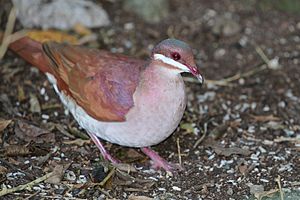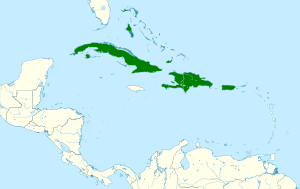Key West quail-dove facts for kids
Quick facts for kids Key West quail-dove |
|
|---|---|
 |
|
| In Cuba | |
| Conservation status | |
| Scientific classification | |
| Genus: |
Geotrygon
|
| Species: |
chrysia
|
 |
|
The Key West quail-dove (Geotrygon chrysia) is a beautiful bird from the dove and pigeon family, known as Columbidae. It is a close relative of the bridled quail-dove.
Contents
Where the Key West Quail-Dove Lives
The Key West quail-dove makes its home and raises its young in the Bahamas and most of the Greater Antilles islands. These islands include places like Cuba, Puerto Rico, and the Dominican Republic. Interestingly, even though it's called "Key West," this bird doesn't usually have its babies in the Florida Keys or southern Florida anymore.
Preferred Habitats
You can find these birds in warm, dry forests and bushy areas. They also like damp forests that are close to sea level. They prefer places with lots of trees and plants where they can find food and shelter.
What the Key West Quail-Dove Eats
These doves spend their time looking for food on the ground. Their main diet includes seeds, berries, and fruits that have fallen from trees. They especially enjoy eating poisonwood fruit, which is safe for them to eat. Sometimes, they will also eat snails.
Reproduction and Life Cycle
Even though they don't usually breed in Florida anymore, you might still see a Key West quail-dove there sometimes. When it's time to lay eggs, the female bird usually lays two buff-colored eggs. She builds a simple nest, often on a shrub, but sometimes right on the ground. This simple nest is called a "flimsy platform."
What the Key West Quail-Dove Looks Like
The Key West quail-dove is about 27 to 31 centimeters (about 11 to 12 inches) long. Its back and wings are a dark, rusty color. Its head, the back of its neck, and its inner wing feathers have a shiny, almost metallic look. This shine can appear amethyst (purplish-red) or bronze-green. A clear white stripe on its face helps to identify it. The sound it makes is similar to the call of the white-tipped dove.
See also
 In Spanish: Paloma perdiz barbiqueja para niños
In Spanish: Paloma perdiz barbiqueja para niños


